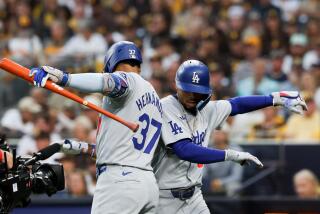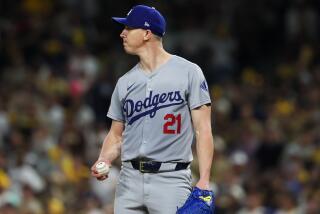A LOOK AT THE ARMS RACE : THE PADRES : A Sneeze Here, a Snooze There--Murphy’s Law Strikes Again
- Share via
SAN DIEGO — It has become San Diego Jack Murphy Stadium law: Anything that can go wrong for a Padre pitcher will.
And usually in the worst possible inning.
It is quite freaky, really.
In April, for instance, Eric Show failed to get a base hit when he supposedly should have, kicked the bat bag, broke a bone in his big toe, tried to cover up the incident, and four months later finally admitted his guilt.
In the meantime, his teammates gave him puny run support and the bullpen didn’t help much, either. He left one game with a 6-1 lead in the seventh, with “a premonition of doom,” and lost. He left another game with a 3-1 lead in the ninth, didn’t have a premonition, yet still lost again.
Fortunately, Show isn’t shy and said last Sunday: “With the way things have gone, with all the freaky hits and weird plays or whatever, I’m kind of getting used to it. My ERA goes down, and my losses go up. How do I explain it all?”
In June, Andy Hawkins had an 11-0 record before he finally lost a ballgame. He didn’t win again for exactly 30 days, but perhaps that could be blamed on all the coffee he drank.
In a rare occurrence, but one typical for the 1985 Padres, he consumed such an abnormal amount of caffeine that it led to a circulatory problem. In particular, his right index finger turned purple. Then a split developed that wouldn’t heal.
He tried pitching with it, but couldn’t throw his slider or cut fastball. Only when he began drinking decaffeinated coffee, and began chewing gum and sunflower seeds instead of tobacco, did his finger return to normal. He has a team-high 16 victories.
“Sometimes I’m stuck with nothing to drink and go ahead and get a soda (with caffeine),” Hawkins said. “The main thing is to cut back, and I’ve done that very well. I used to drink a lot of coffee. I used to have two or three cups in the morning and two or three at night.”
Also in midsummer, Padre reliever Goose Gossage, who was having a marvelous year at age 34, sneezed and threw out his back. Later, he lost that “premonition of doom” game for Show, broke a bat in two, simply stepping on it out of disgust, then injured his right knee in late July.
He threw batting practice this week and most of the Padre hitters chose to wear batting helmets. Gossage told trainer Dick Dent: “I wasn’t even bringing it.” Still, guys kept swinging and missing, and Gossage will be back on the roster Sunday.
Quietly, though, some speculated that he had injured himself stepping on that bat, although the story hasn’t been confirmed.
There’s more, of course. LaMarr Hoyt, the most valuable player in the All-Star game, developed a sore shoulder that possibly can be blamed on a particular umpiring crew. Hoyt, it seems, had been told in spring training by umpire Doug Harvey that no matter how it had been viewed in the American League, Hoyt’s motion constituted a balk in the National.
Harvey’s crew then called five balks against Hoyt, prompting him to change his delivery, which, he thinks, perhaps caused the injury.
Hoyt may not pitch again this season.
Also, middle relievers Tim Stoddard and Craig Lefferts have been inconsistent and, at times, horrendous. Last season, the left-handed Lefferts continually used an effective screwball to set the table for Gossage. His ERA was 2.13. This year it’s 3.01. What’s the difference? The screwball isn’t as screwy.
The result is spotty middle relief. Last year, their World Series year, the Padres won in 23 games when their starters went no more than six innings. This year, they have only nine such wins.
As for Stoddard, whose record is 1-6 with a 4.70 ERA, he has lost most of his games in the 10th inning.
Other luckless fellows are Dave Dravecky and Mark Thurmond. According to Hoyt, Dravecky has been this year’s best Padre pitcher, but he has just 11 victories to show for it. Thurmond was taken from the rotation after he lost both ends of a doubleheader in San Francisco, and only now is he back and pitching nicely again.
All of this was beginning to wear on Jack McKeon, the Padres’ general manager, and since Gossage was injured and since San Diego needed a savior soon, he recalled pitchers Lance McCullers, a 21-year-old right-hander soon to be nicknamed Baby Goose, and Gene Walter, a 24-year-old lefty, from triple-A. Presto. McCullers had three quick saves, and Walter had two.
But San Diego Jack Murphy Stadium Law got them, too. Walter went out to pitch against the Mets, not knowing that his stocking stirrup was hanging out loose. The umpire and Met first base coach let him in on it, giggling, of course, and Walter proceeded to hang slider after slider. The Mets got him.
Meanwhile, McCullers was the victim of a practical joke and then an impractical beating. After a late-night flight from Montreal to New York, he fell asleep on the team bus. His teammates failed to wake him when they arrived at the hotel, and about a mile from the parking garage, lazy Lance woke up and asked the startled bus driver: “Where am I?”
That story got around so well that even his mother back in Tampa, Fla., heard about it and asked him about it. Days later against the Phillies, the team that had drafted him, he suffered his first major league loss, giving up a single, two walks and finally a game-winning hit to Juan Samuel in the bottom of the ninth.
No one was particularly shocked.
Still, if you want to believe statistics, it could be said that Padre starting pitchers are superior to Dodger starters. Sounds crazy, but it may be true.
John Lowe, a reporter for the Philadelphia Inquirer, has figured a new way to measure the efficiency of a starting pitcher, one that appears more accurate than won-lost records or ERAs.
Lowe’s “quality starts” are defined simply as the number of times in a season that a pitcher goes at least six innings and yields no more than three earned runs in a game. He says it’s a better gauge than wins and losses because those can be influenced by the offense or defense. And it’s better than an ERA, he says, since one lousy game can water down 10 good ones in figuring the ERA.
For instance, 25 of Philadelphia’s Jerry Koosman’s 51 earned runs have been scored in six innings spread over five bad starts. If not for those five games, his ERA would be 2.51, not 4.62.
Anyway, if you compare Padre quality starts to Dodger quality starts, San Diego wins, 80-72. Only the Mets, with 84, have more quality starts than San Diego, and Dravecky, with 22, is second only to New York’s Dwight Gooden in the National League with 26. The Dodgers’ Fernando Valenzuela is tied for fifth place with 19.
All of which cuts very little ice with McKeon. “To be honest, when you look on paper, the staff of the Dodgers is still the best staff in the league,” he said.
“Why? Experience. Our guys are a lot like their guys a few years ago. They were feeling their way through, but all of a sudden, they all had it and kept it. Maybe three years from now, our guys like Hawkins, Dravecky, Show and Thurmond, they’ll really know how to pitch.”
The Padre staff is young. Hawkins is 25, Lefferts 27, Thurmond 28, Dravecky and Show 29. Hoyt, the veteran starter, is 30 but McKeon said: “I think he’ll win 13 to 20 games for three or more years, for sure.”
And already in 1985, this staff has more complete games, eight, and more shutouts, 18, than last season’s. The trouble clearly has been middle relief. “It’s been a thorn in our side and I’m not saying something that hasn’t been fairly obvious,” pitching coach Galen Cisco said.
McKeon, though, already has his plan for next season. “Next year, you’re looking at Goose, McCullers, Walter and Lefferts,” he said. “Lefferts will be better because he has Walter (another lefty) and vice versa. The same thing with McCullers and Goose.
“Wouldn’t it be nice to go with (McCullers) in the sixth and seventh and Goose in the eighth or ninth? Or have McCullers go one night and Goose the next? And keep everyone fresh? I’ve been thinking about that for two years.”
In the meantime, there is a month or so left of 1985.
“I sure have been eating a lot of gum and a lot of sunflower seeds,” Hawkins said sarcastically of his new diet, which appears to be a necessity if he plans to keep on pitching this year. “Now, I’ll probably get too much salt in my system or too much sugar, and I’ll have to quit. And then they’ll tell me the beer I drink is bad for me, too. Let’s hope things don’t get that ridiculous.”
DODGERS, PADRES DOWN THE STRETCH
DODGERS
GAMES REMAINING, 39
Opp. Games Opp. Rec. Home Away vs. Opp. + or - .500 Phillies 4 0 4-4 - 8 Expos 3 0 4-5 +12 Mets 3 0 6-3 +25 Braves 2 5 8-3 -18 Reds 3 4 8-3 + 6 Padres 2 2 6-8 +10 Astros 2 3 10-3 - 9 Giants 3 3 6-6 -26 Total 22 17 52-35 - 8
PADRES
GAMES REMAINING, 36
Opp. Games Opp. Rec. Home Away vs. Opp. + or - .500
Expos 3 0 6-3 +12 Mets 3 0 5-4 +25 Phillies 3 0 6-3 - 8 Reds 2 4 6-6 + 6 Astros 3 3 5-7 - 9 Dodgers 2 2 8-6 +25 Giants 3 2 9-4 -26 Braves 3 3 7-5 -18 Total 22 14 52-38 + 7
Dodgers’ biggest lead, 9 games, Aug. 16. (Dodgers 69-44; Padres 61-54).
Dodgers’ biggest deficit, 6 games, June 29. (Padres 44-29; Dodgers 37-34).
Records since June 29: Dodgers 37-15; Padres 24-29.
SEPTEMBER RECORDS
DODGERS PADRES UNDER LASORDA UNDER WILLIAMS 1984 16-11 4th 1984 14-14 1st 1983 14-16 1st 1983 15-12 4th 1982 14-15 2nd 1982 13-16 4th 1981 15-17 1st 1980 19-14 2nd 1979 17-11 3rd 1978 16-13 1st 1977 17-11 1st
More to Read
Go beyond the scoreboard
Get the latest on L.A.'s teams in the daily Sports Report newsletter.
You may occasionally receive promotional content from the Los Angeles Times.










